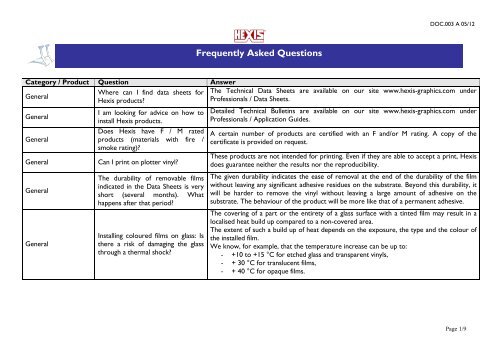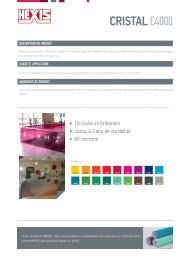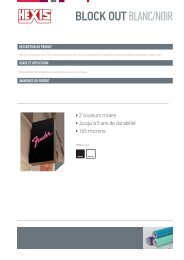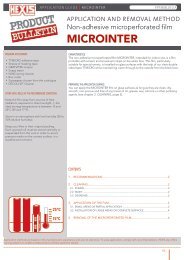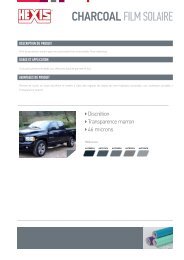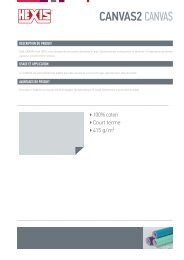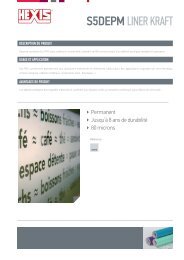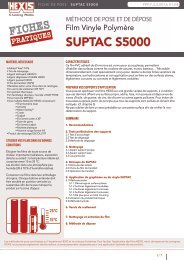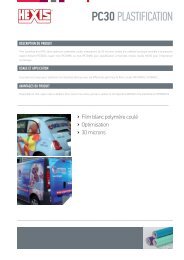Download - Hexis
Download - Hexis
Download - Hexis
Create successful ePaper yourself
Turn your PDF publications into a flip-book with our unique Google optimized e-Paper software.
DOC.003 A 05/12<br />
Frequently Asked Questions<br />
Category / Product Question<br />
Where can I find data sheets for<br />
General<br />
<strong>Hexis</strong> products?<br />
General<br />
General<br />
General<br />
General<br />
General<br />
I am looking for advice on how to<br />
install <strong>Hexis</strong> products.<br />
Does <strong>Hexis</strong> have F / M rated<br />
products (materials with fire /<br />
smoke rating)?<br />
Can I print on plotter vinyl?<br />
The durability of removable films<br />
indicated in the Data Sheets is very<br />
short (several months). What<br />
happens after that period?<br />
Installing coloured films on glass: Is<br />
there a risk of damaging the glass<br />
through a thermal shock?<br />
Answer<br />
The Technical Data Sheets are available on our site www.hexis-graphics.com under<br />
Professionals / Data Sheets.<br />
Detailed Technical Bulletins are available on our site www.hexis-graphics.com under<br />
Professionals / Application Guides.<br />
A certain number of products are certified with an F and/or M rating. A copy of the<br />
certificate is provided on request.<br />
These products are not intended for printing. Even if they are able to accept a print, <strong>Hexis</strong><br />
does guarantee neither the results nor the reproducibility.<br />
The given durability indicates the ease of removal at the end of the durability of the film<br />
without leaving any significant adhesive residues on the substrate. Beyond this durability, it<br />
will be harder to remove the vinyl without leaving a large amount of adhesive on the<br />
substrate. The behaviour of the product will be more like that of a permanent adhesive.<br />
The covering of a part or the entirety of a glass surface with a tinted film may result in a<br />
localised heat build up compared to a non-covered area.<br />
The extent of such a build up of heat depends on the exposure, the type and the colour of<br />
the installed film.<br />
We know, for example, that the temperature increase can be up to:<br />
- +10 to +15 °C for etched glass and transparent vinyls,<br />
- + 30 °C for translucent films,<br />
- + 40 °C for opaque films.<br />
Page 1/9
Category / Product Question<br />
General (continued)<br />
General<br />
General<br />
General<br />
General<br />
DIGITAL PRINTING<br />
General<br />
DIGITAL PRINTING<br />
Choice of product<br />
Choice of product<br />
Can I install a film with a removable<br />
adhesive on top of a film with a<br />
permanent adhesive?<br />
What does the expression<br />
“180° peel” on the Technical Data<br />
Sheets mean (under adhesive<br />
properties)?<br />
What does the term “initial tack”<br />
indicated on the Technical Data<br />
Sheets mean (under adhesive<br />
properties)?<br />
How to choose a vinyl for screenprinting?<br />
Do I have to laminate a solvent,<br />
eco-solvent waterbased inkjet print?<br />
Which product should I use for<br />
installation on concrete surfaces,<br />
building walls, structured<br />
surfaces…?<br />
Which product can I use on a<br />
curtainsided lorry?<br />
DOC.003 A 05/12<br />
Answer<br />
In all cases such a build up of heat cannot by itself provoke the deterioration of the glass.<br />
Nevertheless if a fault in the glass existed beforehand, the build up of heat due to the film<br />
may provoke a crack in the glass. Therefore make sure the glass is in perfect condition<br />
before the installation of the film.<br />
The adhesion of one film on top of another can be done without problem. Nevertheless<br />
you will loose the removability of the film on top of the film with the permanent adhesive. It<br />
will be more difficult to remove the film after a certain time.<br />
The measurements of the adhesive forces of our products are carried out on glass plates.<br />
To do this test, the film is partially applied on the plate.<br />
We then measure the force that is necessary to peel the film from the plate by pulling at<br />
180° at the loose end of the strip.<br />
The tack is the value for the immediate adhesion of a film on a substrate, without having<br />
applied it. We measure the adhesion force on glass, without having applied any pressure on<br />
the film.<br />
The vinyls for solvent / eco-solvent inkjet printed can be screenprinted. In the case of sites<br />
without humidity control or with strong variations in humidity levels, it is recommended to<br />
prefer films on a PE liner.<br />
This is strongly recommended. Laminating a print increases its durability. The laminate<br />
protects the print against abrasion and/or UV rays.<br />
Use VCSR100WG1.<br />
Caution: the installation method is peculiar. Refer to the Technical Bulletin available on our<br />
website www.hexis-graphics.com.<br />
The vinyl curtains on lorries are a peculiar substrate as they tend to be rolled and unrolled<br />
frequently. At the moment <strong>Hexis</strong> does not offer a product suitable for constraints of this<br />
type.<br />
Page 2/9
Category / Product Question<br />
Choice of product<br />
(continued)<br />
Choice of product<br />
Choice of product<br />
Which product should I use for<br />
striping on the floor?<br />
Which product should I use on low<br />
energy plastics (polyethylene,<br />
polypropylene)?<br />
DOC.003 A 05/12<br />
Answer<br />
Exception: we offer a reflective product for lorry curtains (reflective marking on banner<br />
material), which is used for a very specific application (reflective contour marking of<br />
lorries).<br />
Use Suptac with a floor laminate GSOL170 (Caution: indoor use only).<br />
Use a product with a reinforced adhesive, such as:<br />
- Digital printing media: VCR100WG1, VCR200WG1, VCR3000WG1.<br />
- Plotter vinyl: VCRE3000.<br />
You can choose a solar film for buildings along the following criteria:<br />
- The tint of the required film,<br />
- whether you prefer installing the film on the inside or the outside of the window,<br />
- the type of glass (simple, double glazing, tinted or not),<br />
- the durability.<br />
Choice of product –<br />
Solar films<br />
How to choose a solar film for<br />
buildings?<br />
Indoor<br />
Exposure<br />
Oudoor<br />
Tinte<br />
Clear<br />
flat<br />
glass<br />
Compatibility with glass<br />
Tinted Clear<br />
flat double<br />
glass glazing<br />
Tinted<br />
double<br />
glazing<br />
Durability<br />
BSOR20i2 10 years<br />
BSOR20x2 3 years<br />
Silver<br />
reflective<br />
BSOR35i2 10 years<br />
BSOR35x2 3 years<br />
BSOR50i2 <br />
10 years<br />
BSOB20i2 10 years<br />
Bronze<br />
BSOB20x2 <br />
3 years<br />
BSON20x2 3 years<br />
BSON50i2 <br />
BSOT35i2 <br />
BSOM15i2 <br />
Grey, non<br />
reflective 10 years<br />
Reflective<br />
(thermal 5 years<br />
reflection)<br />
Mirror<br />
without tint<br />
10 years<br />
Page 3/9
Category / Product Question<br />
Special substrates<br />
Can I apply on polycarbonate (e.g.<br />
Makrolon ® ), or on PMMA (e.g.<br />
Plexiglas ® )?<br />
DOC.003 A 05/12<br />
Answer<br />
These products outgas over a lapse of time. If this happens, bubbles may appear under the<br />
film. It is recommended to degas before the installation of a film. To do this, heat the<br />
substrate for a couple of seconds with the life flame of a blowtorch (blue tip of the flame).<br />
Be careful not to deteriorate the substrate (do not keep the flame for longer than one<br />
second on the same spot).<br />
Special substrates<br />
Special substrates<br />
Tips and tricks<br />
Transparent /<br />
Translucent<br />
Etched Glass Vinyl<br />
Can the film be applied on the hull<br />
of a ship?<br />
Can it be installed in a swimming<br />
pool (total or partial immersion)?<br />
How to remove an old vinyl film?<br />
What is the difference the<br />
Transparent and Translucent<br />
ranges?<br />
What is the difference between the<br />
HX5DEPM and the S5DEPM?<br />
Yes, as long as it is a rigid hull. Do not apply on inflatable boats (of the type Zodiac ® ).<br />
Avoid the use of products with Hex’Press liner.<br />
It is recommended to protect the edges of the film with a marine varnish.<br />
Wait for at least 48 hours before floating the ship.<br />
The walls must be rigid (tiles, solid walls…). Make sure the film adheres to the substrate.<br />
Avoid the use of products with Hex’Press liner.<br />
Wait for at least 48 hours before refilling the pool.<br />
<strong>Hexis</strong> does not accept any responsibility in case the film peels on the edges.<br />
Use a heat gun. Start peeling the film in a corner / on the edge of the film. Pull the film,<br />
while heating with the heat gun. Progressively proceed with the peeling of the film, pulling<br />
gently while heating at the same time.<br />
If the film is too brittle, using the DECAPTOUT liquid will help (Careful: beforehand always<br />
check the compatibility liquid – substrate). Leave the liquid to soak for a couple of<br />
moments. The liquid will soften up the film so that it becomes easy to scrape it with a<br />
squeegee.<br />
If any adhesive residues remain on the substrate, you can remove them with the<br />
DECOLL’VIT liquid. In the particular case of a vehicle body you may use the product 1-<br />
REMOVER from the1-2-3 liquid cleaning system.<br />
The coloured transparent film is intended for applications on glass.<br />
The translucent film is a semi-opaque product intended for lightboxes. In a backlit<br />
application the films becomes translucent.<br />
The PVC films are identical (same durability).<br />
The HX5DEPM carries a structured adhesive to allow an easy evacuation of bubbles and a<br />
faster installation. This product is dry applied.<br />
The S5DEPM carries a smooth adhesive and be wet applied.<br />
Page 4/9
Category / Product Question<br />
Etched Glass Vinyl<br />
Erasable whiteboard<br />
What is the difference between the<br />
S5DEPM and the V203EG?<br />
Can it be printed?<br />
DOC.003 A 05/12<br />
Answer<br />
The PVC films are identical (same durability).<br />
The S5DEPM is intended for cutting plotter application. The V203EG is intended for solvent<br />
inkjet printing; in production it is controlled in view of such an application.<br />
No. This product is designed to impede the fixing on inks on its surface (erasability) and<br />
therefore cannot be printed.<br />
To obtain a printed, erasable substrate, proceed as follows: print the graphic on a white<br />
printable vinyl, leave to dry for at least 24 hours and then laminate with a clear erasable<br />
whiteboard film.<br />
Erasable whiteboard Can it be used outdoors? No, indoor use only (not resistant to UV rays).<br />
Erasable whiteboard<br />
The product cannot be erased<br />
anymore. What can I do?<br />
The film can be cleaned with a window cleaner or with ethyl alcohol.<br />
Flex<br />
To find out about the applications, refer to the Technical Data Sheet and the Technical<br />
Who does it work?<br />
Bulletin available from our website Internet www.hexis-graphics.com.<br />
What are the conditions for the<br />
Flex<br />
transfer onto a fabric?<br />
Flex What are the conditions for<br />
laundering Flex?<br />
Flex<br />
Flex PLOTTER VINYL<br />
Flex<br />
Can the Flex be used outdoors (on<br />
awnings)?<br />
Can I superpose two flex PLOTTER<br />
VINYLS?<br />
On which fabrics can I apply Flex?<br />
This will depend on the flex and the fabric used. Refer to the Technical Data Sheet and the<br />
Technical Bulletin available from our website Internet www.hexis-graphics.com.<br />
Wash inside out at 40°C (104°F) maximum. Can be tumble dried. Iron inside out.<br />
The product is not intended for such applications (in particular as far as resistance to<br />
outdoor conditions is concerned).<br />
Yes.<br />
The fabric must be resistant to the operation conditions of the press. In case of any doubt,<br />
carry out a preliminary test to check the compatibility of the fabric. It is also possible to put<br />
a sheet of baking paper between the Flex and the hot plate of the press. This will allow<br />
protecting the fabric against the heat to some extent.<br />
Page 5/9
Category / Product Question<br />
Answer<br />
DOC.003 A 05/12<br />
Flex (continued)<br />
Liquids<br />
Liquids<br />
What do I use to remove an old<br />
vinyl?<br />
How do I remove traces of<br />
adhesive left after the removal of an<br />
old vinyl?<br />
Refer to the following compatibility chart:<br />
Reference Cotton Nylon Polyester<br />
Sublimated<br />
Polyester<br />
Lycra<br />
Uflex 3 ̌ ̌ ̌<br />
Uflex 5 ̌ ̌<br />
With<br />
precautions*<br />
̌<br />
UF1200 ̌ ̌ ̌ ̌<br />
UF1250 ̌<br />
UF1400 ̌<br />
Flex200 ̌ ̌ ̌<br />
Flex300 ̌<br />
Flex400 ̌<br />
Flex697C<br />
DIGITAL<br />
PRINTING<br />
PLOTTER VINYL<br />
(reflective)<br />
̌ ̌ ̌<br />
Flex697N<br />
(reflective)<br />
̌<br />
* Refer to the Technical Bulletin for flex DIGITAL PRINTING.<br />
Use DECAPTOUT or DECOLL’VIT.<br />
Be careful with the substrate: always carry out a preliminary test before the use of a liquid to<br />
ensure it does not damage the substrate.<br />
Use DECOLL’VIT.<br />
In the case of a vehicle body, you may use the product 1-REMOVER of the liquid cleaning<br />
system 1-2-3.<br />
Be careful with the substrate: always carry out a preliminary test before the use of a liquid to<br />
ensure it does not damage the substrate.<br />
Liquids<br />
How do I clean an antigraffiti film<br />
(AG700, AG800)?<br />
Use HEX’AG.<br />
Magnetic Can it be cut in a plotter? No, the product is too thick. It can be cut with a box cutter.<br />
Magnetic<br />
Magnetic<br />
Can it be printed?<br />
Can it be used on vehicles?<br />
It is preferable to print on a printable white, which can then be applied on the Magnetic.<br />
Yes, by complying with a certain number of precautions outlined in the Technical Data Sheet.<br />
Refer to the data sheet before any application on a vehicle.<br />
Page 6/9
Category / Product Question<br />
Microperforated<br />
How to choose a microperforated<br />
film?<br />
Answer<br />
Depending on the application, <strong>Hexis</strong> offers a range of microperforated films:<br />
Reference<br />
Micro2<br />
Micro4<br />
Micro140UV<br />
MicroM0<br />
DOC.003 A 05/12<br />
Use<br />
Long-term applications (durability of 3 years (printed, laminated)).<br />
Print with solvent, eco-solvent, HP-latex inkjet.<br />
Short-term applications. Removal with no significant adhesive residues<br />
(depending on the substrate, within 3 months after application).<br />
Print with solvent, eco-solvent, HP-latex inkjet.<br />
Specially designed for printing with UV curing inks.<br />
If you need an M0 fire rating (outdoor application): Use the MicroM0.<br />
Microperforated<br />
Microperforated<br />
Microperforated<br />
Microperforated<br />
What is the rate of perforation /<br />
hole size of the<br />
microperforated films?<br />
Can it be installed on the<br />
emergency exits of public transport<br />
vehicles?<br />
Which laminate should I use on a<br />
microperforated film?<br />
Can I print a microperforated film<br />
with UV curing inks?<br />
Reference Hole size (mm) Perforation (%)<br />
Micro2 1,5 32<br />
Micro4 1,5 32<br />
Micro140UV 1,5 40<br />
MicroM0 1,5 50<br />
No, the law does not allow the installation of films on emergency exits.<br />
PC50MICP2 for curved windows (rear windows of vehicles).<br />
PG836 for flat windows (buildings).<br />
Because of its specific liner, the Micro140UV is specially designed for printing with UV curing<br />
inks.<br />
The other references of the Microperforated film are not compatible with this technology, as<br />
the UV inks may clog up the holes in the film.<br />
Page 7/9
Category / Product Question<br />
Can I wet apply a laminate on a<br />
Laminates<br />
solvent print?<br />
Laminates<br />
Laminates<br />
Paintmask<br />
What do I use to laminate a graphic<br />
printed with UV curing inks?<br />
Can I use the floor laminate<br />
(GSOL170) for outdoor<br />
applications?<br />
Which paintmask do I use for which<br />
application?<br />
Answer<br />
Blackboard<br />
Can I write with chalk pens (or felt<br />
No, only with chalk.<br />
pens)?<br />
Blackboard Can it be used outdoors? No, indoor use only.<br />
Tapes<br />
Tapes<br />
Which tape to choose for which<br />
plotter application?<br />
What is the difference between the<br />
paper tapes and the clear tapes?<br />
Yes.<br />
DOC.003 A 05/12<br />
Use:<br />
- the VCR750,<br />
- or the AGCR700 if, in addition, you want to add anti-graffiti protection to the print.<br />
No, this product is intended for indoor use only.<br />
For an application of paint on smooth surfaces (smooth walls, glass, banner…) use the<br />
STENCIL paintmask.<br />
For an application of paint on canvas, awnings, canopies… use the Lambrequin<br />
paintmask.<br />
For an application of paint on hard surfaces (marble, granite, glass…) use the M1000.<br />
paintmask<br />
There are tapes with more or less tack (= adhesion):<br />
- to transfer small sized cuts, use a tape with a high tack.<br />
- to transfer mat vinyl, it is recommended to use a high tack tape.<br />
- to transfer large sized cuts, use a tape with a low tack.<br />
- for “difficult” products (HX5DEPM), fluorescents (F610 range), carbon vinyls<br />
(HX30CA000B, S5CANB range), we recommend the use of the tape HEX588.<br />
Clear tapes have the advantage of being transparent and they thus make the positioning on<br />
the cut vinyl easier. However the choice of material is above all a matter of personal<br />
preference: some users prefer paper tapes, others clear tapes.<br />
Category / Product Question<br />
Answer<br />
Page 8/9
Tapes<br />
Tapes<br />
How long can I leave a tape on a cut<br />
vinyl before the transfer?<br />
I need a tape that I can leave on the<br />
cut vinyl for a rather long time<br />
without peeling off (e.g. for kits).<br />
DOC.003 A 05/12<br />
It is recommended to put the tape on the cut vinyl just before the application.<br />
If you need to leave the tape on the cut vinyl for any length of time before the application, it<br />
is recommended to use a special tape for “kits”: HEX100 or HEX910 (cf. next line).<br />
There are two tapes specially for kits:<br />
- the HEX100 paper tape.<br />
- the HEX910 clear tape.<br />
Tapes<br />
Tyvek / Robuskin<br />
Sealing<br />
VR7077<br />
Sealing<br />
VR7077<br />
varnish<br />
varnish<br />
I find it difficult to transfer my cut<br />
vinyl with my tape. I cannot lift the<br />
cut vinyl off the liner. What can I<br />
do?<br />
What is the difference between<br />
Tyvek and Robuskin?<br />
How to remove an old sealing<br />
varnish?<br />
The product is too thick / turned<br />
solid in the container; how can I<br />
liquefy it?<br />
First try and proceed the other way round:<br />
- Put the tape on the cut vinyl.<br />
- Vigorously apply the tape with the help of a squeegee.<br />
- Turn the whole complex over, liner (protective paper) up.<br />
- Carefully remove the liner at an angle of 180°. If necessary aid the lifting off of the<br />
film from the edge with a finger. The cut vinyl should stay on the tape.<br />
If this does not help, try a tape with a higher tack<br />
For “difficult” products (HX5DEPM, fluorescents (F610 range), carbon vinyl (HX30CA000B,<br />
S5CANB range)), we recommend the use of the tape Hex588.<br />
The ROBUSKIN is the thinner of the two. It has a "smooth" surface appearance.<br />
The TYVEK is thicker and more resistant. It has a "parchment" appearance. It is rated « tear<br />
resistant».<br />
Use acetone.<br />
Dilute with a small quantity of xylene or white spirit.<br />
Note: Because of the great variety of substrates and new possible application methods, the user must examine the suitability of the media for each application.<br />
All published data are based on measurements carried out regularly under laboratory conditions. They do not, however, constitute an intangible guarantee. The seller assumes no liability for indirect damage and will<br />
only assume financial responsible for a sum corresponding to the price of his products. All our specifications are subject to changes without prior notification. The specifications listed on our website are<br />
automatically updated: www.hexis-graphics.com.<br />
HEXIS S.A. Tel.: +33 - 4 67 18 66 80<br />
Z.I. Horizons Sud - CS 970003 Fax: +33 - 4 67 48 38 79<br />
34118 FRONTIGNAN CEDEX e-mail: marketing@hexis.fr www.hexis-graphics.com<br />
Page 9/9


